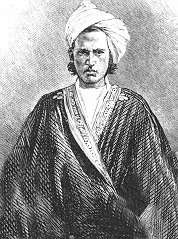Sheekhaal
| Regions with significant populations | |
|---|---|
| Languages | |
| Somali and Arabic | |
| Religion | |
| Islam (Sunni) | |
| Related ethnic groups | |
| Siddiquis, Qallu, Harari people, Arabs and other Somali clans |
The Sheekhaal (var. Sheikhaal, Sheikal, Shikal) (Arabic: شيخال), also known as Fiqi Omar, is a Somali clan. Group members inhabit Somalia, Ethiopia and with considerable numbers also found in the Northern Frontier District (NFD) in Kenya.
Overview

Sheekhal traces its ancestry to Sheikh Abadir Umar Ar-Rida, also known as Fiqi Umar, who in turn traced his lineage to the first caliph, Abu Bakr (Sayid Abubakar Al-Sadiq). According to the explorer Richard F. Burton, In his book "First Footsteps in East Africa". The Sheekhaash or Sheekhaal is described as the only Somalis of the mountains not derived from Dir and Darood. They claim descent from "Caliph Abu Bakr" and asserted that their ancestor Khutab bin Fakih Umar crossed over from Al-Hijaz.[1] Fiqi Umar crossed over from the Arabian Peninsula to the Horn of Africa with his six sons: Umar the Greater, Umar the Lesser, the two Abdillahs, Ahmad and Siddik.[2] Sheikh Ar-Rida is also regarded as the saint of Harar.[3]
Some Sheekhal clans, specifically members of the Ahmed Loobage sub-lineage, consider themselves to be members of the larger Hawiye clan. However, others within the Ahmed Loobage subclan would argue that while they are politically aligned with the larger Hawiye clan, this does not mean that they are descendants of Hawiye.[4] This view is shared by the Aw-Qutub, one of the major Sheekhal subclans; they too totally reject the notion that the Sheekhal are part of the Hawiye clan in terms of descent. UNHCR considers the Sheekhal as a separate group, with four sub-clans: Lobogay (Loboge), Aw Qudub, Gendershe and Aw Hassan (Reerow-Xassan).[5] Lewis (1982) mentions that the largest clan of the Sheikhal is the Reer Fiqi Omar, whose most important lineage, the Reer Aw Qutub, inhabit Somali region of Ethiopia.[6] The Sheekhal clans were reportedly not considered as part of the Hawiye until after the civil war.[4]
Most of the Sheekhaal in the borders of Somalia are associated with the Hiraab Hawiye section. An example of how a weak clan may change it's clan affiliation to gain protection and influence. General Liiqliqato, who was a Sheikhal, described in his book how the Sheikhal became associated with the Hawiye and added as ‘Martileh Hiraab’ (literally meaning guests of Hiraab).[7] So it should be noted that although the Sheekhaal do not claim descent from Hawiye or Irir Samaale they are politically associated with Hawiye.
Shekhal are also mentioned to be one of the religious minorities of Somalia having faced multiple human rights abuses.[8]
Sheikhaal sub-clans
- Aw-Qutub[9]
- Aw Axmed Loobage[9](Found in Lower Shebelle, Banadir, Bay, Jubaland and North Eastern Province)
- Aw Cismaan Gandarshe (Found in Banadir) [9]
- Gaameedle Gandarshe[9]
- Jaziira (also known as Baa Xassan, found in Banadir)[9]
- Qallu[9]
- Teedan[9]
- Abiib[9]
- Cali Cafiif[9]
- Gudle[9]
- Cabdi Shekh[9]
- Cabdi Sufi[9]
- Cabdisamad[9]
- Sheikh Hayti[9]
- Seyle[9]
Prominent figures
- Abadir Umar Ar-Rida (Fiqi Omar)
- Xasan Fiqi Cumar[10]
See also
References
- ↑ Burton, Richard Francis (1856-01-01). First Footsteps in East Africa. Longman, Brown, Green & Longmans. p. 193.
- ↑ Richard Burton, First Footsteps in East Africa, 1856; edited with an introduction and additional chapters by Gordon Waterfield (New York: Praeger, 1966), p. 165
- ↑ Siegbert Uhlig, Encyclopaedia Aethiopica: He-N, Volume 3, (Otto Harrassowitz Verlag: 2007), pp.111 & 319.
- 1 2 Hassan Ali Jama (2005). Who Cares About Somalia. Berlin: Verlag Hans Schiler. p. 140. ISBN 3-89930-075-0.
- ↑ Joint British, Danish and Dutch fact-finding mission to Nairobi, Kenya (2000-11-24). "Report on minority groups in Somalia" (PDF). Nairobi, Kenya. p. 55. Retrieved 2013-01-02.
- ↑ Lewis, I.M (1982). A study of pastoralism and politics among the northern Somalis of the Horn of Africa (PDF). New York: Africana Publishing Company. pp. 10–11.
- ↑ https://www.ecoi.net/file_upload/90_1261130976_accord-report-clans-in-somalia-revised-edition-20091215.pdf Clans in Somalia Report on a Lecture by Joakim Gundel, COI Workshop Vienna, 15 May 2009 (Revised Edition) published December 2009
- ↑ http://minorityrights.org/wp-content/uploads/old-site-downloads/download-912-Click-here-to-download-full-report.pdf
- 1 2 3 4 5 6 7 8 9 10 11 12 13 14 15 Aves Osman Hagi; Abdiwahid Osman Hagi (1988). Clan, sub-clan, and regional representation in the Somali government organization, 1960-1990: statistical data and findings. Washington DC: Aves O. Hagi & Abdiwahid O. Hagi. p. 156.
- ↑ Dr. Omar Ali. Qabaa ilka Soomaalida1988. Mogadishu, Somalia: Banaadir Press. p. 27.